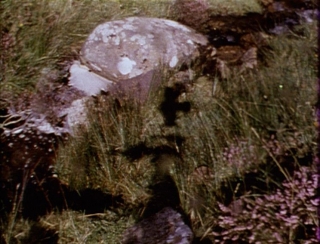Date: 31 May 2008 | Season: Videoex 2008 | Tags: Shoot Shoot Shoot
SHOOT SHOOT SHOOT: 2
Saturday 31 May 2008, at 6pm
Zurich Videoex Festival Cinema Z3
The 1960s and 1970s were a defining period for artists’ film and video in which avant-garde filmmakers challenged cinematic convention. In England, much of the innovation took place at the London Film-Makers’ Co-operative, an artist-led organisation that incorporated a distribution office, projection space and film workshop. Despite the workshop’s central role in production, not all the work derives from experimentation in printing and processing. Filmmakers also used language, landscape and the human body to create less abstract works that still explore the essential properties of the film medium.
Malcolm Le Grice, Threshold, 1972, colour, sound, 10 mins
Chris Welsby, Seven Days, 1974, colour, sound, 20 mins
Peter Gidal, Key, 1968, colour, sound, 10 mins
Stephen Dwoskin, Moment, 1968, colour, sound, 12 mins
Gill Eatherley, Deck, 1971, colour, sound, 13 mins
William Raban, Colours of this Time, 1972, colour, silent, 3 mins
John Smith, Associations, 1975, colour, sound, 7 mins
PROGRAMME NOTES
SHOOT SHOOT SHOOT: 2
Saturday 31 May 2008, at 6pm
Zurich Videoex Festival Cinema Z3
THRESHOLD
Malcolm Le Grice, 1972, colour, sound, 10 mins
“Le Grice no longer simply uses the printer as a reflexive mechanism, but utilises the possibilities of colour-shift and permutation of imagery as the film progresses from simplicity to complexity … With the film’s culmination in representational, photographic imagery, one would anticipate a culminating ‘richness’ of image; yet the insistent evidence of splice bars and the loop and repetition of the short piece of found footage and the conflicting superimposition of filtered loops all reiterate the work which is necessary to decipher that cinematic image.” (Deke Dusinberre, LFMC catalogue 1993)
SEVEN DAYS
Chris Welsby, 1974, colour, sound, 20 mins
“The location of this film is by a small stream on the northern slopes of Mount Carningly in southwest Wales. The seven days were shot consecutively and appear in that same order. Each day starts at the time of local sunrise and ends at the time of local sunset. One frame was taken every ten seconds throughout the film. The camera was mounted on an Equatorial Stand, which is a piece of equipment used by astronomers to track the stars. Rotating at the same speed as the earth, the camera is always pointing at either its own shadow or at the sun. Selection of image (sky or earth; sun or shadow) was controlled by the extent of cloud coverage. If the sun was out the camera was turned towards its own shadow; if it was in the camera was turned towards the sun.” (Chris Welsby, LFMC catalogue 1978)
KEY
Peter Gidal, 1968, colour, sound, 10 mins
“Slow zoom out and defocus of …” (Peter Gidal, LFMC catalogue 1974)
MOMENT
Stephen Dwoskin, 1968, colour, sound, 12 mins
“One single continuous shot of a girl’s face before, during and after an orgasm. A concentration on the subtle changes within the face – going from an objective look into a subjective one and then back out … Moment is not a woman alone, but with her ‘in person’. Have you ever really watched the face in orgasm?” (Stephen Dwoskin, Other Cinema catalogue 1972)
DECK
Gill Eatherley, 1971, colour, sound, 13 mins
“During a voyage by boat to Finland, the camera records three minutes of black and white 8mm film of a woman sitting on a bridge. The preoccupation of the film is with the base and with the transformation of this material, which was first refilmed on a screen where it was projected by multiple projectors at different speeds and then secondly amplified with colour filters, using positive and negative elements and superimposition on the London Co-op’s optical printer.” (Gill Eatherley, Light Cone catalogue, 1997)
COLOURS OF THIS TIME
William Raban, 1972, colour, silent, 3 mins
“Whilst working on previous time-lapse films, I found that colour film tended to record the actual colour of the light source rather than local colour when long time exposures were used. Using this phenomenon, Colours of this Time records all the imperceptible shifts of colour temperature in summer daylight, from first light until sunset.” (William Raban, LFMC catalogue 1974)
ASSOCIATIONS
John Smith, 1975, colour, sound, 7 mins
“Text taken from ‘Word Associations and Linguistic Theory’ by Herbert H. Clark. Images taken from magazines and colour supplements. By using the ambiguities inherent in the English language, Associations sets language against itself. Image and word work together/against each other to destroy/create meaning.” (John Smith, LFMC catalogue 1978)
Back to top
